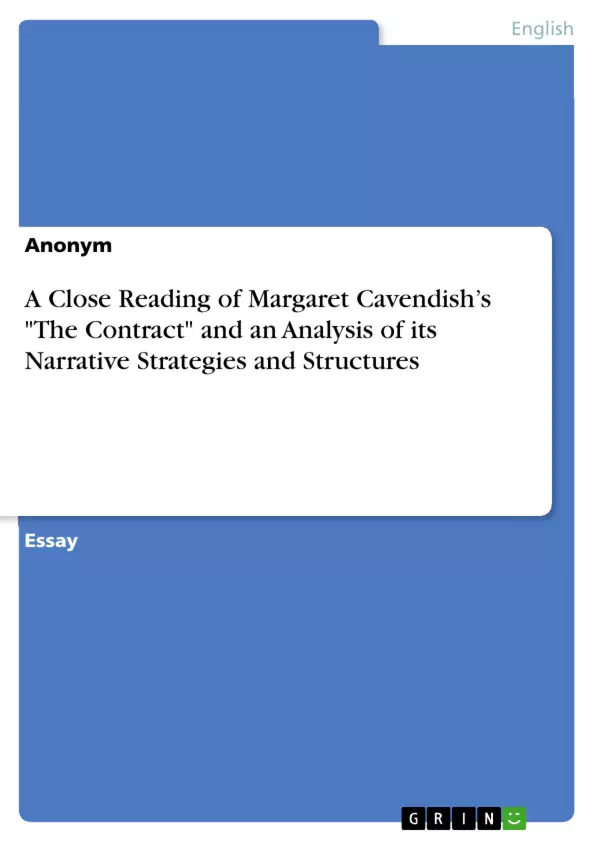The aim of this essay on Margaret Cavendish’s novel "The Contract" is to approach the text from a new perspective and to attempt a close reading of the narrative strategies in the novel and the way the mode of narration mirrors society’s wish to capture and determine social relations.
Research has already shown that "The Contract" is “the earliest extended critique in English prose fiction of the marriage market from a woman’s standpoint” (Donovan 59). Attention has been drawn to the political references and allusions made in "The Contract", and to the gender issues that are being raised in the novel.
Concerning the former, Victoria Kahn has reminded us that romances were used politically during the reign of Charles I and the Protectorate (527) and has emphasized the analogy between the marriage contract and “the hierarchical, inequitable political relations of sovereign and subject” (527). This analogy is especially valid in the contemporary context of the engagement controversy (1649-1652), “when parliament sought to secure alliance to the new government of Cromwell after the execution of Charles I” and a statement of engagement had to be signed by all male citizens (535). According to her, "The Contract" raises questions about the validity (529), the different sorts of contracts, and the motivation of people to sign contracts (526). Kahn has shown that The Contract is a comment on “contemporary debates about political obligation”, a comment that argues for a form of political obligation “that is based on love rather than on filial obligation” (529), and which ironically makes the royalist Cavendish “draw[] near to the parliamentarians’ theory of an original and revocable contract between the people and their ruler” (530).
Inhaltsverzeichnis (Table of Contents)
- I. Introduction
- II. Narrative strategies and structures in The Contract
- a. Part one: presentation of the characters and of the ‘problem’
- b. Part two: Quest for a solution
- c. Part three: Arrival in the city and masque
- d. Part four: The anagnorisis
- e. Part five: Quest for a solution to the new problem
- f. Part six: The dénouement
- III. Conclusion: social conditionality and self-made determination and their relation to love in The Contract
Zielsetzung und Themenschwerpunkte (Objectives and Key Themes)
This essay on Margaret Cavendish's novel The Contract examines the narrative strategies employed in the text and how they reflect society's desire to control and define social relationships. The essay aims to provide a close reading of the narrative techniques used by the author and to explore the relationship between the mode of narration and the attempts to fix social relations within the depicted society.
- Narrative strategies and structures in The Contract
- Social conditionality and self-made determination
- The role of contracts in shaping social relations
- The opposition between artificial contracts and natural love
- The power of love to disrupt social conventions
Zusammenfassung der Kapitel (Chapter Summaries)
The first part of the novel introduces the main characters and the central conflict surrounding marriage and societal expectations. The narrator provides detailed biographical information, highlighting the importance of social status, age, and the forces that shape individuals' lives. This section emphasizes a sense of determinism, where characters' actions are seemingly predetermined by their past experiences and social circumstances.
The second part focuses on the quest for a solution to the initial problem, introducing conditional clauses and highlighting the characters' weighing of potential actions and their consequences. This section explores how decisions affect the social world and how characters attempt to manipulate outcomes through careful consideration of conditions and effects.
The third part shifts to the arrival of the main characters in the city and a significant masque. The narrative strategy changes, emphasizing the use of adverbs of time to meticulously detail events. This approach creates an impression of the narrator's thoroughness and reliability.
The fourth part marks the anagnorisis, or the moment of recognition between the main characters, Deletia and the Duke. The narrator's usage of the adversative conjunction "but" reflects the antagonism between the characters' desires and the complexities of their newfound knowledge. This part introduces parallel narratives, highlighting the different perspectives and motivations of the key players.
In the fifth part, the narrative shifts to a dialogical approach as the characters engage in conversations and debates concerning the next steps. The narrator takes a more passive role, primarily mediating between the characters' speeches, which intensifies the sense of directness and realism. This section emphasizes the characters' attempts to anticipate consequences and control their futures through careful consideration of conditions and possibilities.
Schlüsselwörter (Keywords)
Key terms and concepts explored in The Contract include: narrative strategies, social determinism, contracts, marriage, social relations, love, artificiality, naturalness, and power dynamics. The essay examines the author's use of language, specifically causal and conditional clauses, adverbs of time, and adversative conjunctions, to analyze how these linguistic elements contribute to the overarching themes of the novel.
- Quote paper
- Anonym (Author), 2014, A Close Reading of Margaret Cavendish’s "The Contract" and an Analysis of its Narrative Strategies and Structures, Munich, GRIN Verlag, https://www.grin.com/document/336373



